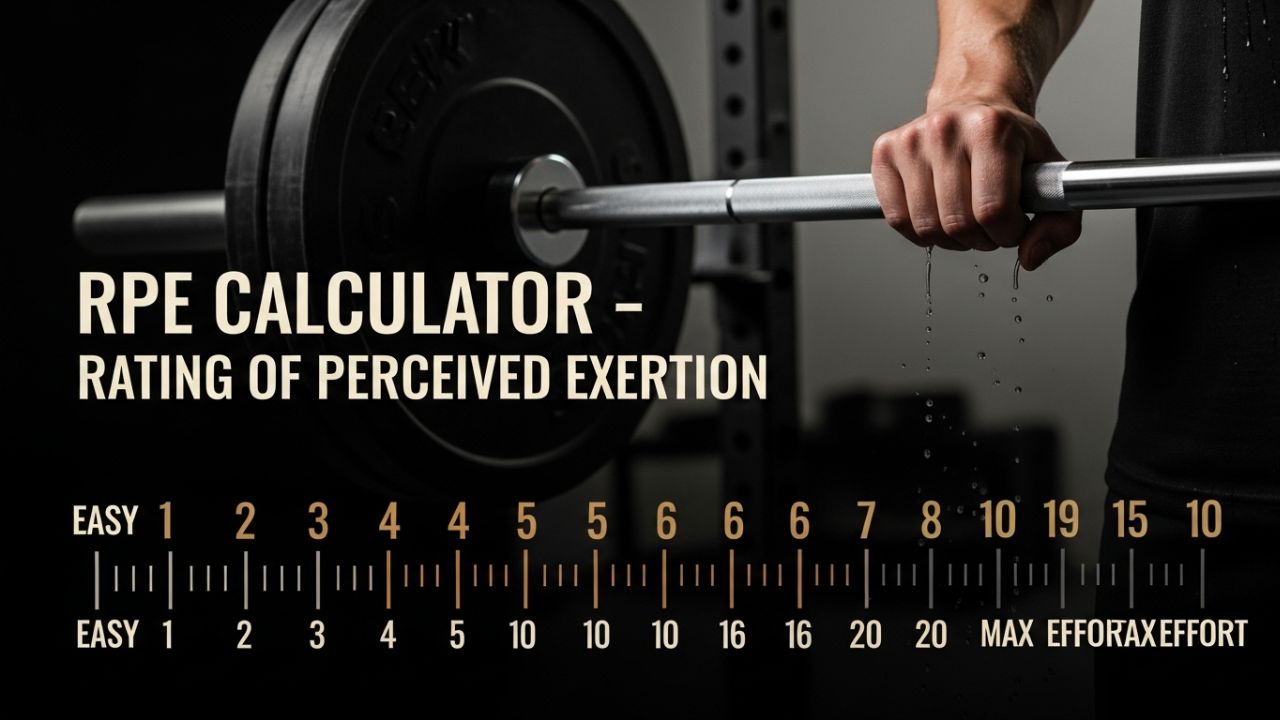RPE Calculator
Calculate your Rating of Perceived Exertion using official scales for strength training (1-10 RIR) and cardio (0-10 modified) with 1RM estimation and heart rate zones

What is Rating of Perceived Exertion (RPE)?
Rating of Perceived Exertion (RPE) is a scientifically validated scale used to measure exercise intensity based on how hard you feel your body is working. Recent research from Sports Medicine Open (2024) involving 6,311 participants confirms that RPE provides reliable intensity assessment across different populations, with median values of RPE 13 at 2 mmol/l lactate, RPE 15 at 3 mmol/l, and RPE 16 at 4 mmol/l.
Scientific Foundation
Developed by Dr. Gunnar Borg in the 1960s, the RPE scale correlates strongly with physiological markers including heart rate, oxygen consumption, and blood lactate levels. Clinical research demonstrates correlation coefficients of 0.80-0.90 between RPE and objective exercise intensity measures, making it an invaluable tool for exercise prescription when laboratory testing isn’t available.
Clinical Applications
Healthcare professionals and fitness experts use RPE for cardiac rehabilitation, athletic training, and general fitness programming. Studies in clinical populations show that RPE-guided exercise prescription produces similar physiological adaptations to heart rate-based training while being more accessible and cost-effective.
Advantages Over Other Methods
Unlike heart rate monitors or lactate testing, RPE requires no equipment and accounts for individual factors like fatigue, environmental conditions, and medication effects. Research indicates that RPE remains consistent across different exercise modalities and provides immediate feedback for intensity adjustment during training sessions.
RPE Scales & Training Applications
The strength training RPE scale ranges from 1-10 and incorporates Reps in Reserve (RIR). This scale is specifically designed for resistance training and 1RM estimation.
The modified 0-10 scale is used for cardiovascular exercise and rehabilitation programs. It’s easier to understand and correlates well with heart rate zones.
RPE Formulas & 1RM Estimation
RPE 9 = 95.5% (1 RIR)
RPE 8 = 92.2% (2 RIR)
RPE 7 = 89.2% (3 RIR)
Female: 209 – (0.9 × Age)
Training Intensity Guidelines
| RPE Range | Strength Training | Cardio Training | Training Purpose | Recommended Duration |
|---|---|---|---|---|
| 1-3 | Recovery/Technique | Very Light | Active recovery, skill development | 30-60 minutes |
| 4-5 | Light Training | Light Aerobic | Base building, aerobic development | 45-90 minutes |
| 6-7 | Moderate Training | Moderate Intensity | Hypertrophy, aerobic fitness | 30-60 minutes |
| 8-9 | High Intensity | Vigorous Exercise | Strength, power, VO2 max | 20-45 minutes |
| 10 | Maximum Effort | Maximal Intensity | Testing, competition | 5-20 minutes |
Scientific Research & Validation
Large-Scale Validation Study (2024)
“Rating of Perceived Exertion: A Large Cross-Sectional Study”
Sports Medicine – Open, Volume 10, Article 71 (2024) –
This comprehensive study of 6,311 participants provides updated RPE recommendations: RPE ≤11 for light intensity, RPE 12-14 for moderate intensity,
and RPE 15-17 for vigorous intensity. The research identifies key factors influencing RPE including age, sex, fitness level, and exercise duration.
Clinical Application Research
“The Use of RPE in Clinical Practice”
PMC Clinical Study –
Demonstrates the reliability and validity of RPE across diverse clinical populations, showing strong correlations with objective physiological measures
and successful application in cardiac rehabilitation, pulmonary rehabilitation, and chronic disease management programs.
Strength Training RPE Research
“RPE-Based Training Load Quantification”
ResearchGate Sports Medicine Review –
Comprehensive review of RPE applications in resistance training, demonstrating strong correlations between RPE and %1RM,
with practical applications for autoregulation and periodization in strength training programs.
Practical Applications & Training Strategies
🏋️ Strength Training Applications
Autoregulation: Use RPE to adjust training loads based on daily readiness and fatigue levels.
1RM Estimation: Calculate theoretical maximum lifts without performing dangerous max attempts.
Load Progression: Systematically increase intensity while monitoring perceived effort.
Deload Planning: Reduce RPE during recovery weeks while maintaining movement patterns.
❤️ Cardiovascular Training Applications
Zone Training: Target specific heart rate zones using RPE as a guide when HR monitors aren’t available.
Interval Training: Prescribe work and rest intervals based on perceived exertion levels.
Endurance Building: Maintain consistent aerobic intensity for long-duration sessions.
Recovery Monitoring: Use low RPE sessions to promote active recovery and adaptation.
🎯 Programming Considerations
Individual Variation: Account for personal differences in RPE perception and training experience.
Environmental Factors: Consider temperature, humidity, and altitude effects on perceived exertion.
Medication Effects: Understand how medications (especially beta-blockers) may affect RPE accuracy.
Training Age: Recognize that RPE accuracy improves with training experience and body awareness.
Limitations & Important Considerations
While RPE is a valuable tool for exercise prescription and monitoring, several factors should be considered:
- Learning Curve: Accurate RPE assessment requires practice and body awareness development.
- Individual Variation: RPE perception can vary significantly between individuals and populations.
- Environmental Factors: Heat, humidity, altitude, and time of day can affect RPE accuracy.
- Psychological State: Motivation, mood, and stress levels influence perceived exertion ratings.
- Training Experience: Novice exercisers may have less accurate RPE perception than experienced athletes.
- Exercise Modality: RPE may vary between different types of exercise (resistance vs. cardio vs. sports).
- Medication Effects: Beta-blockers and other medications can affect heart rate and RPE relationships.
- Fatigue State: Accumulated fatigue can alter RPE perception independent of actual exercise intensity.
Important Note: Use RPE as one tool among many for exercise prescription. Combine with objective measures when possible, and always prioritize proper form and safety over achieving specific RPE targets. Consider individual circumstances and consult with qualified professionals for personalized training guidance.
⚕️ Medical Disclaimer
This RPE calculator provides estimates based on validated research and should not replace professional medical or coaching advice. Individual responses to exercise can vary significantly due to health status, fitness level, and other factors. The calculations provided are for educational purposes and general guidance only. Consult with certified exercise professionals, sports scientists, or medical professionals before making significant changes to training programs, especially if you have pre-existing health conditions, are taking medications, or are new to exercise.
Related
- Barbell Racking Calculator
- Push-Up Weight Calculator
- Wilks Calculator
- DOTS Calculator
- One-Rep (1RM) Max Calculator
- One-Rep Max (1RM) Bench Press Calculator
- Max Weighted Pull Up Calculator
- VO2 Max 12-Minute Cooper Test Calculator
- VO2 Max Calculator: Know Your Aerobic Capacity
References
- Centers for Disease Control and Prevention. (2022, June 3). Perceived exertion (Borg rating of perceived exertion scale) https://www.cdc.gov/physicalactivity/basics/measuring/exertion.htm
- Helms, E. R., Cronin, J., Storey, A., & Zourdos, M. C. (2016). Application of the Repetitions in Reserve-Based Rating of Perceived Exertion Scale for Resistance Training. Strength and conditioning journal, 38(4), 42–49. https://doi.org/10.1519/SSC.0000000000000218
- Williams, N. (2017). The Borg Rating of Perceived Exertion (RPE) Scale. Occupational Medicine, 67(5), 404-405. https://doi.org/10.1093/occmed/kqx063
- Morishita, S., Tsubaki, A., Takabayashi, T., & Fu, J. B. (2018). Relationship between the rating of perceived exertion scale and the load intensity of resistance training. Strength and Conditioning Journal, 40(2), 94.
- Jo, D., & Bilodeau, M. (2021). Rating of perceived exertion (RPE) in studies of fatigue-induced postural control alterations in healthy adults: Scoping review of quantitative evidence. Gait & Posture, 90, 167-178.
- Ciolac, E., Mantuani, S., Neiva, C., Verardi, C., Pessôa-Filho, D., & Pimenta, L. (2015). Rating of perceived exertion as a tool for prescribing and self regulating interval training: A pilot study. Biology of Sport, 32(2), 103.

Manish is a NASM-certified fitness and nutrition coach with over 10 years of experience in weight lifting and fat loss fitness coaching. He specializes in gym-based training and has a lot of knowledge about exercise, lifting technique, biomechanics, and more.
Through “Fit Life Regime,” he generously shares the insights he’s gained over a decade in the field. His goal is to equip others with the knowledge to start their own fitness journey.
